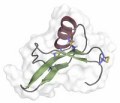
A new naturally derived artificial sweetener could soon hit the market, thanks to the development of a mass production technique devised by University of Wisconsin-Madison research Fariba Assadi-Porter. The sweetener, known as brazzein, is a 54 amino acid protein derived from an extract of the fruit of the tropical plant Pentadiplandra brazzeana Baillon. It has been eaten in West Africa across the millennia, but only recently caught the attention of the West because of its incredible sweetness. The protein extract tastes sweet only to humans and old-world monkeys and is is 2000 times sweeter than sucrose when compared to a 2% solution of sugar.
Assadi-Porter and her colleagues are using spectroscopy to help them understand the relationship between the structure of this protein and its sweetness. They have recently devised a new approach to fermenting it on a large scale and startup company Natur Research is now seeking FDA approval to commercialise the protein as a food stuff for the low-calorie drinks and food industries. A paper detailing the production process has now been accepted by Protein Expression and Purification Journal, and you can read more about the story in the NMR channel on SpectroscopyNOW.
More on proteins in this week’s issue: Roderick MacKinnon and his colleagues at Rockerfeller U have come up with a novel technique, lipid-detergent-mediated crystallization, that allows them to crystallise membrane proteins, such as the voltage-dependent potassium ion channel, in as near as natural state as possible. The approach could open the door to countless studies of membrane proteins using crystallography that have not previously been possible. More on that in the SpectroscopyNOW X-ray ezine, here
Also in this week’s round up, news not related directly to proteins and molecular biology. Researchers in Canada and the US have used MRI to demonstrate that there is something like a three-year delay in the development of certain regions of the brain in children with ADHD. The most obvious delay is seen in the front cortex, a region important in thinking, concentration, and planning. Rather than worrying parents, the discovery should be reassuring to parents and sufferers, says Philip Shaw of the NIMH Child Psychiatry Branch who led the research because although there is a delay, brain development is otherwise normal. “Finding a normal pattern of cortex maturation, albeit delayed, in children with ADHD should be reassuring to families and could help to explain why many youth eventually seem to grow out of the disorder,” he says.
The research also revealed that the regions affected by the developmental delay are coincident with the regions that develop precociously in children with autism. More on the scan results, again in SpectroscopyNOW.